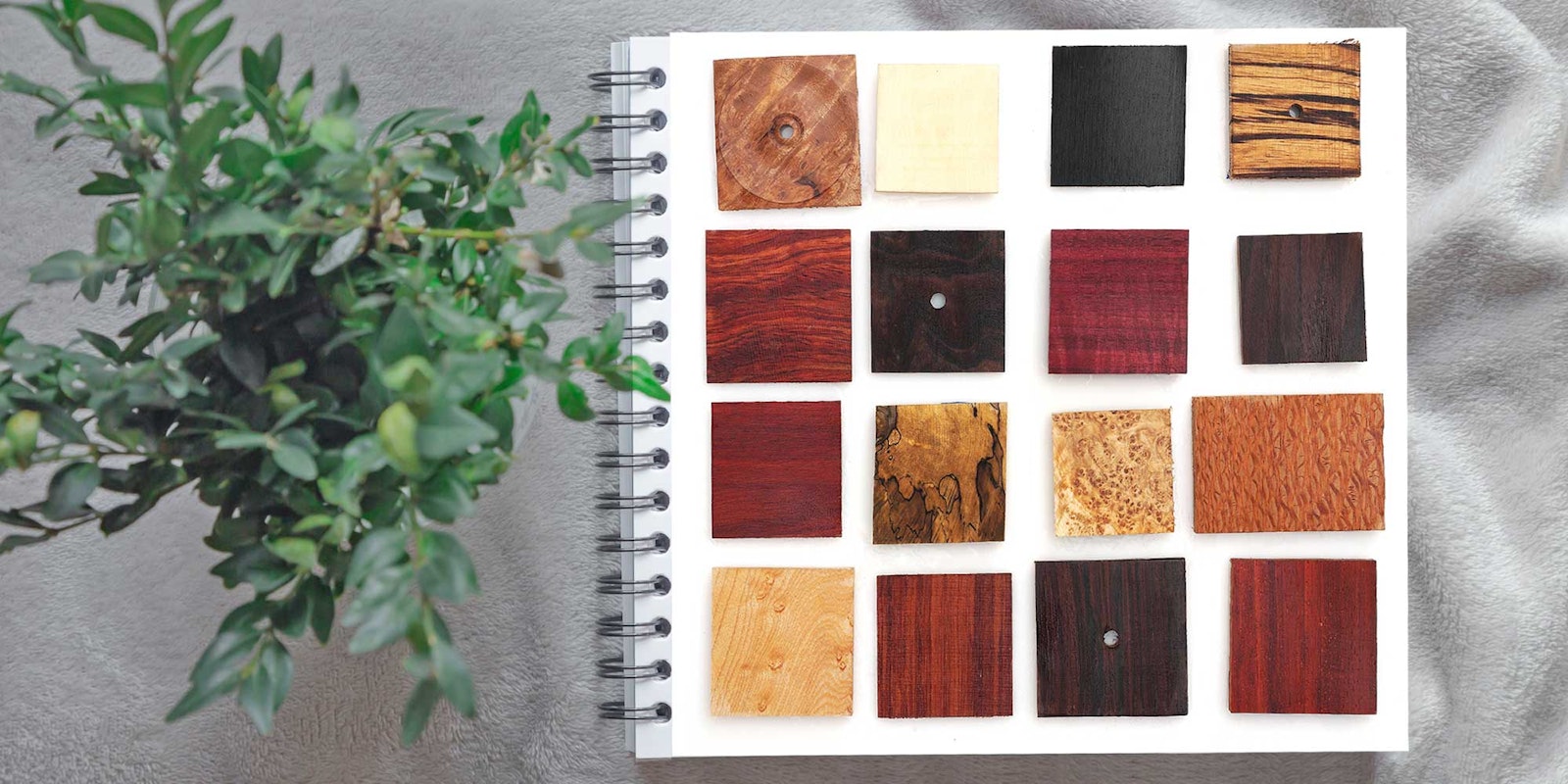Just like the different fleeces that we covet for their unique characteristics, each piece of lumber contains its own special attributes. Instead of micron count or staple length, there are visions of color, grain, and knots.
With thousands of varieties of trees in the world, and when wood from two trees of the same species differs, the creative possibilities in woodworking are endless. Some examples are shown in the above photo (from left to right, top to bottom) Row 1: maple burl, holly, Gabon ebony, zebrawood. Row 2: figured bubinga, figured burl black walnut, purpleheart, Bolivian rosewood. Row 3: bloodwood, spalted maple, black ash burl, lacewood. Row 4: bird’s-eye maple, bubinga, cocobolo, padauk.
Common woods for spindle construction may include a number of North American trees such as maple, oak, birch, cherry, and walnut. For centuries, woodworkers have highlighted the beauty of these familiar woods in furniture and cabinetry, and spinners have coveted spindles made of special woods. Although they may be familiar by name, what do we really know of these woods?
 A rough piece of wood in place on the lathe (left); the lathe in motion (right). Photo by Kathy Augustine
A rough piece of wood in place on the lathe (left); the lathe in motion (right). Photo by Kathy Augustine
Maple conjures up images of shade trees with swings and of syrup making in Vermont. Maple is also used for bowling pins, baseball bats, and musical instruments. With over one hundred species worldwide, the hard wood of maple can exhibit a decorative grain with characteristics known as flame maple, quilt maple, and bird’s-eye maple.
Stately oaks comprise over six hundred species. Their high tannin content means they are naturally resistant to insect and fungal attack. Lumber created by using the quartersawn technique highlights the oak grain with its medullary ray pattern, a desirable look for furniture and paneling. Along with sturdy timber used for shipbuilding since the days of the Vikings and the thousands of oak barrels filled with aging wine and whiskey, oaks also produce an abundance of acorns perfect for every squirrel’s winter stash.
 Black birch and cherry wood, joined and carved by Carl Bieling Jr., create whorls for “checkerboard” spindles. Photo by Kathy Augustine
Black birch and cherry wood, joined and carved by Carl Bieling Jr., create whorls for “checkerboard” spindles. Photo by Kathy Augustine
The birch family, which includes alders, hazels, and hornbeams, comprises a number of species throughout the northern hemisphere’s temperate climate. This fine-grained light-colored hardwood has a satin sheen that sometimes shows a beautiful rippling pattern. It can be found in furniture, model airplanes, and skateboards.
Besides being known for delicious pies made from its fruit, cherry, which was once called New England mahogany by colonial furniture makers, has its own respected place in the woodworking world. With numerous varieties worldwide, it is the black cherry wood that is of commercial value. The wood, light pinkish brown when first cut, turns to a deep red-brown color when exposed to sunlight, highlighting its straight satiny grain.
This article was excerpted from the Fall 2016 issue of Spin Off. To read the full article, “A Walk in the Spindle Woods,” download Fall 2016 Spin Off.
Also, remember that if you are an active subscriber to Spin Off magazine, you have unlimited access to previous issues, including Fall 2016. See our help center for the step-by-step process on how to access them.
Need help selecting the right spindle? Check out “How to Pick the Right Spindle for the Job.”
Enticed by the notion that she would have “plenty of time,” Kathy Augustine purchased her first spinning wheel over 25 years ago shortly before going on maternity leave. It was only about 15 years ago that her wheel began to receive the attention it deserved. She and her husband live in Pennsylvania with their furry and fleecy family of several cats, a dog, a mohair goat, and sheep.
Originally published April 24, 2018; updated August 7, 2023.

